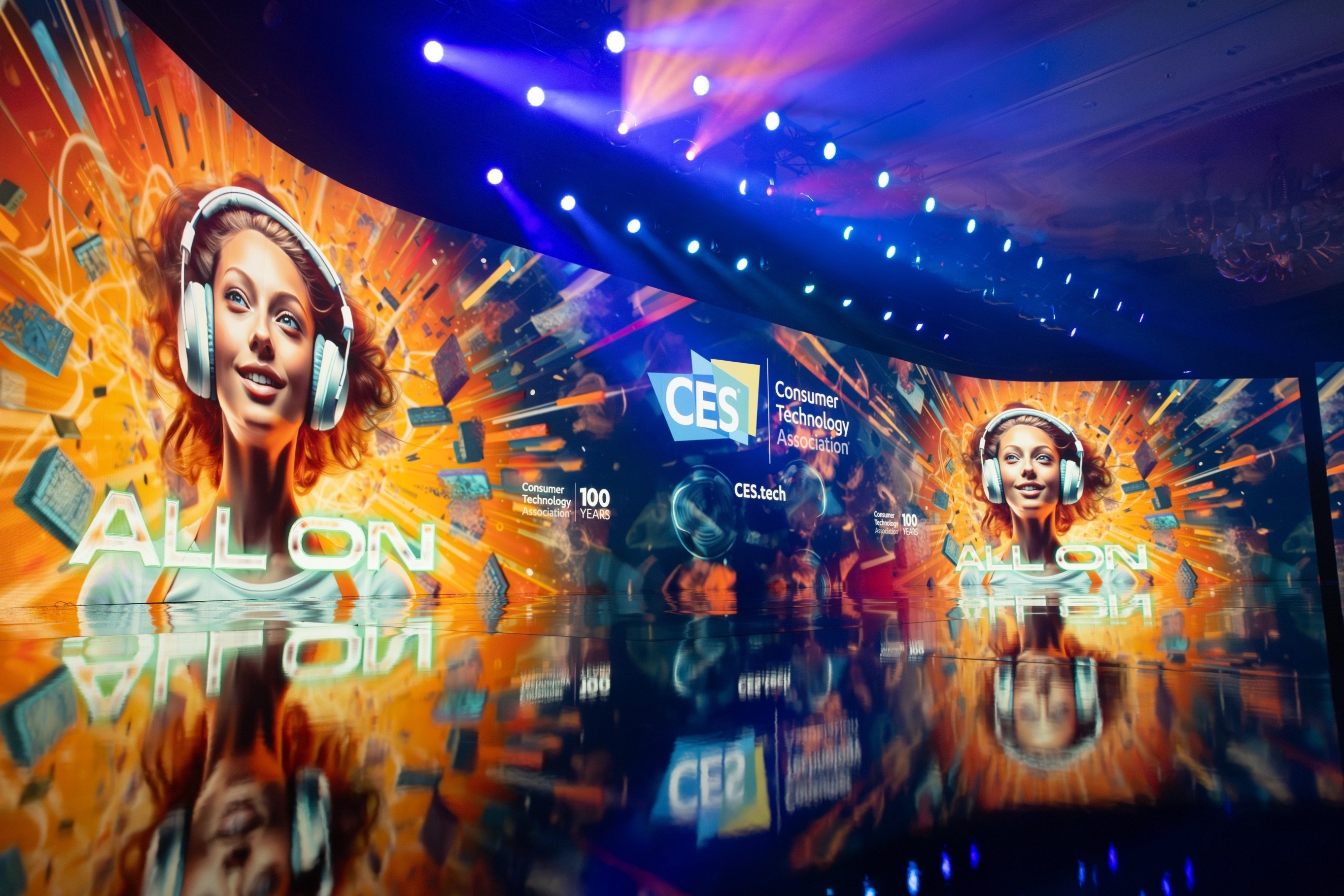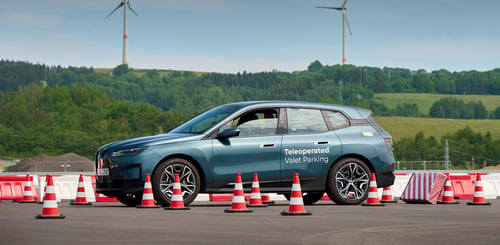
Automotive technology yet again played a significant role at the 2024 Consumer Electronics Show (CES), with more intelligent in-car voice controls, new eye monitoring tech and visual displays, plus the latest generation of chips and processors designed to deliver even more capable software-defined vehicles. The Detroit-based OEMs may have been absent this year, but this didn’t deter attendees, with 135,000 visitors from 150 countries at the show - up year-on-year.
Parkopedia sets the agenda for in-car commerce and releases US Driver Survey Report
Parkopedia once again attended CES in 2024, hosting our own in-car commerce event - a breakfast briefing with a highlighted panel on ‘Enabling the mass adoption of in-car commerce’, featuring Parkopedia’s COO, Hans Puvogel, plus Nissan North America Director of Product Strategy, Innovation and Software Services, Vishnu Jayamohan, Visa Director of IoT, Anthony Petit, Valtech MD Automotive and Mobility, Peter Ivanov and TechInsights Director of Automotive Connected Mobility, Roger Lanctot.

This session covered the current state of the in-car payment industry and the role in-car commerce plays for each of the companies featured, plus the hurdles that may have held up adoption to date. Following this, Parkopedia and Valtech highlighted the importance of cleverly integrated in-car services to ensure a seamless experience for drivers - something which many in-car systems fail to provide. Finally, the participants discussed the opportunities for drivers and the automotive industry made possible by getting in-car commerce right, along with the essential factors needed to ensure mass adoption.
We also published our US Driver Survey Report ahead of CES 2024, highlighting how US drivers experience more significant parking and charging issues than drivers across Europe and Japan. The report shows how 18% of American drivers experience problems every time they look for parking, while 68% of US EV drivers have been issued unexpected parking fines while charging. Download the US Driver Survey Report for more information on the parking and charging challenges facing American motorists and their preferences for connected car services.
Scope of in-car voice control grows with the addition of generative AI tech in automotive
Voice control functionality has been available in vehicles for decades, however, CES 2024 showcased a new generation of intelligent systems, with Mercedes-Benz promising a more human in-car virtual assistant and Volkswagen integrating ChatGPT into models with VW’s IDA voice assistant, offering control over infotainment, navigation and climate systems. BMW and Amazon, meanwhile, focused on voice assistant capabilities that enable drivers to learn about their car’s functionality without having to read the manual.
Mercedes’ MBUX Virtual Assistant uses software and generative AI to make interactions with the car more natural and is set to be rolled out in upcoming Mercedes models running on the MMA platform (Mercedes-Benz Modular Architecture), being previewed at CES in the Concept CLA Class. This system can learn driver behaviour and situational context to gauge what the driver wants at certain times or in certain places - either making suggestions or automating these actions for maximum convenience.
Potential examples include tuning to a specific radio station to hear the morning news when commuting or offering to dial directly into a meeting if the car recognises that the driver is running late for a meeting logged in the calendar. All of these actions are led by four ‘personality traits’ - Natural, Predictive, Personal and Empathetic, which are intended to provide a seamless, intelligent and proactive experience for the driver.
ChatGPT is set to appear in Volkswagen’s EV models including the ID 3, ID 4, ID 5 and ID 7 along with petrol- and diesel-powered Golf, Tiguan and Passat models. This functionality will firstly be available in Europe from Q2 2024 onwards and is integrated into the back end of Volkswagen’s IDA voice assistant, which can currently be used to control in-car systems.
The addition of ChatGPT enables these models to provide vehicle-specific information, address questions and interact using intuitive language, according to Volkswagen, though Volkswagen isn’t the first automaker to integrate this, with Mercedes-Benz adding ChatGPT to its MBUX infotainment system in June 2023.
BMW and Amazon’s new Alexa LLM-powered (Large Language Model) voice assistant functionality, meanwhile, enables drivers to ask questions about in-car functions - rather than having to search through a print or online manual - with the voice assistant providing ‘easy-to-understand’ answers. Topics covered could potentially include what the car’s drive modes do and how parking assist systems work.
Transition to Software-Defined Vehicles (SDV) accelerates with suppliers driving progress
Hyundai announced a new ‘Software-defined Everything’ (SdX) approach at CES, with the company aiming to create a branded mobility ecosystem, including a new infotainment system that enables Hyundai to provide its own vehicle app market - reducing reliance upon external tech companies, such as Google and Apple.
This format offers the opportunity for Hyundai to gain additional customer data and potential revenue, too. To maximise engagement, the company intends to “provide software development kits for developers to create killer apps”, as well as integrate Large Language Models (LLM) within its AI assistant, providing more natural interactions.
Following this, Hyundai plans to simplify the process of operating large fleets, with tools including fleet management services plus real-time data analytics and scope for vehicle insights without relying on additional telematics devices.
Chip manufacturer Intel, meanwhile, announced its first Software-Defined Vehicle ‘System-on-Chip’ (SoC), which features AI to provide greater functionality, such as generative AI features plus driver and passenger monitoring. Intel has recently purchased a company specialising in EV energy management and AI-enhanced software for running digital cockpits, which should enable Intel to provide efficient EV energy management solutions.
Intel’s new approach is ‘open, consolidated, software-defined, connected’, according to the company, compared with current ‘fixed-function, distributed’ formats and potentially involves automotive hardware as well as software. The benefit of this is that it should more than halve the number of ECUs (Electronic Control Units) needed and enable ongoing over-the-air feature updates.
Bosch, on the other hand, presented the first central vehicle computer able to run infotainment and Advanced Driver Assistance System (ADAS) features through a single System-on-Chip (SoC). Panasonic Automotive Systems Company of America’s contribution at CES 2024, meanwhile, was its High-Performance Compute (HPC) system - ‘Neuron’. With vehicles becoming increasingly reliant upon software, Neuron facilitates both software and hardware upgrades across platform lifecycles, which should ensure that older cars continue to offer up-to-date software-reliant features - such as assisted or autonomous driving.
Tech companies show off their cars as automakers show off their tech
Eye-tracking technology is already used widely in new cars to gauge whether the driver is paying attention to the road ahead, but new Bosch eye-tracking features, announced at CES 2024, could provide useful driver prompts and offer advertising revenue for automakers, by gauging exactly where motorists are looking.
This system could provide contextual information, such as shop opening times - or vehicle-centric information, such as parking and charging information provided by Parkopedia - to assist drivers directly. Should this technology be combined with point-of-interest information, it provides the opportunity for OEMs to gain referral fees or advertising revenue from highlighted businesses.
BMW also showcased similar technology for delivering information to drivers with its ‘XReal Air 2 AR’ glasses, which can beam infotainment and navigation information in front of the driver’s eyes.
Automated Valet Parking (AVP) and Automated Valet Charging previews at CES
Parkopedia already offers intelligent AVP functionality to the automotive industry, providing detailed car park layouts to vehicles, and enabling them to navigate autonomously into designated parking locations.
BMW’s remote system, announced at CES, transitions to Type 1 autonomous functionality (the same as Parkopedia’s solution), a format that relies on in-vehicle intelligence and integrated features that are already present in vehicles and is likely the most scalable of all solutions due to the reduced infrastructure costs. BMWs demo, showcased a video feed that is shared to a remote ‘teleoperation driver’ who can then park a car without having to sit in it. According to BMW, this system, shown in the BMW iX concept, uses technology that enables both autonomous driving and remotely-controlled valet parking up to speeds of 10km/h. Possible use cases presented by the car company include moving rental cars around a car park, directing cars across assembly plants and enabling drivers to work or relax while being driven around by the vehicle near the end destination.

VW subsidiary Cariad and Bosch, presented a different use for autonomous driving technology at CES; automated valet charging, which is currently being tested. This setup offers scope to direct EVs to empty charging spaces, at which point a charging robot can plug them in autonomously. Once the battery is recharged, the car can leave the space itself, freeing up the charger for another vehicle.
This system should maximise utilisation of charging spaces, minimising wait times and address the most significant EV driver complaint flagged in the 2023 Parkopedia Global Driver Survey; not being able to access charging spots, as they are occupied by another vehicle - a problem experienced by 49% of global respondents.
Final takeaways from CES 2024
CES 2024 was packed with striking automotive developments and here are my key conclusions from the event and Parkopedia’s Breakfast Briefing.
Firstly, in-car commerce is now highly relevant for drivers, with motorists’ requests for connected car services growing consistently, and OEMs need to find ways to make these services available to drivers in a user-friendly manner. Secondly, the US Driver Survey report, released ahead of the event, highlights how parking and charging problems are a significant stress for drivers, and a large proportion of motorists want seamless in-car parking and charging services to address these directly with accurate data and transactions as part of their navigation experience.
More intelligent and context-aware AI-informed voice assistants are becoming more common and offer scope for a greater range of services - not only can voice assistants streamline the process of setting the temperature and navigation destination but they can serve drivers more effectively by helping them access many of the features in their car that they may not be aware of - whether that’s drive modes or in-car data such as parking and charging information.
Current vehicles are packed with increasingly complex software and hardware. Developing vehicles as Software-defined Vehicles (SdV) from the start is crucial to ensure the greatest functionality and longevity of the connected car services expected by an increasing proportion of motorists. Meanwhile, user-friendly integration of eye-tracking or AR features offers the potential to provide more information about nearby points of interest to drivers, plus new commercial opportunities for OEMs.
Finally, there seems positive progress in the autonomous and automated technology sectors and OEMs aligned to Type-1 AVP technology with reliance now on integrated vehicle technology as opposed to infrastructure, combatting scalability challenges. Automated Valet Charging initiatives previewed, offer significant potential for optimising charging capacity around the world. This would help to address the worldwide problem of charging spaces being fully occupied - an issue flagged by half of drivers in the Parkopedia Global Driver Survey - and could play a big role in addressing wait times for drivers while increasing revenue for charging providers.
While there are barriers to overcome for many of these new technologies, it’s clear that drivers and businesses now expect vehicles to be more intelligent - informed by data and providing seamless and convenient services to motorists, the public and companies alike. We can say with confidence that 2024 is destined to be a year to remember for vehicle technology.
As Parkopedia's Chief Product Officer, Duncan's main responsibilities include driving the growth of our product portfolio, ensuring customers' ongoing success from our products and the quality and efficiency of our product operations. Duncan has an extensive product development background, including multiple executive roles within e-commerce and logistics technology companies prior to Parkopedia.
.png?width=1960&height=1103&name=parkopedia%20logo%20+%20arrive%20(1).png)